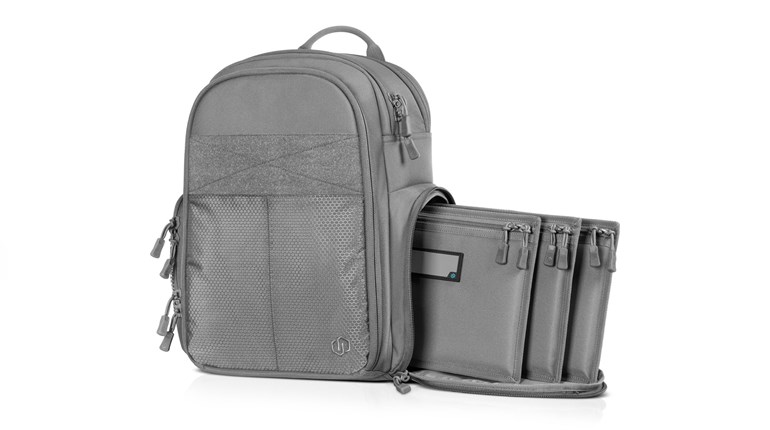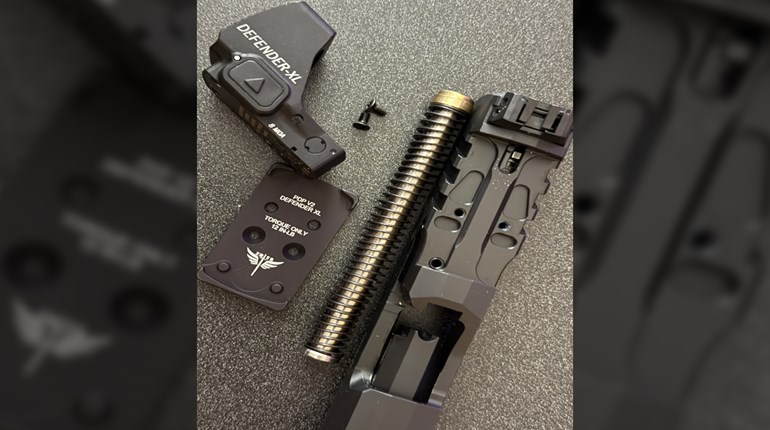
Editor’s note: This review by Daniel McElrath was published in the February 2004 issue of Shooting Sports USA, but the information in it is still of interest to precision (bullseye) pistol shooters, as well as practical shooting enthusiasts.
Pardini’s GT 45 is a modified Browning-type, short-action, recoil-operated pistol. The pistol was initially dubbed the PC 45, but was changed to GT 45 to clarify that it is a sporting pistol and ease importation. Originally intended for action shooting, the design proved so accurate Pardini chose to market it as both an action pistol and a bullseye pistol.
The six-inch GT 45 comes with—quite obviously—a six-inch barrel. This enhances balance and sight radius and also has the effect of increasing velocity. A five-inch-barreled version is also available and seems better-suited to action shooting. It handles a bit quicker and seems to cycle faster.
On either gun, the slide is steel and has a blackened matte finish that doesn’t reflect glare back to the shooter despite the absence of top strap grooves. It has cocking serrations at the rear and another set about a third of the way back from the muzzle.
The frame is CNC-machined from one piece of aluminum alloy. It has a wide, comfortable beavertail and oversized controls, including an ambidextrous thumb safety. It also features a recurved and serrated trigger guard and machine-checkered front and back straps. There are also checkered wood grip panels with Torx-head grip screws. The GT 45 has a double-stack frame design and comes with two blued, 10-round magazines. The front sight is interchangeable, and a micrometer-adjustable rear unit comes with the GT 45, should you not opt for a red-dot sight.

The star of the show, though, is the GT 45’s trigger. The shallowly curved and serrated, single-action unit is fully adjustable for sear engagement, trigger-pull weight, takeup and overtravel. It is crisp and light and won the praise of all who tried the pistol.
The GT 45 generated considerable interest while at the NRA due both to its similarities to—and departures from—the 1911 design. One staffer regarded it as a melding of 1911 and SIG P210 design principles, given it’s 1911-style short-action recoil operation and its P210-esque internal frame rails.
The six-inch GT 45 is a big gun with its long barrel and double-wide frame, yet the aluminum alloy makes it feel lighter than it appears. The grip angle and the long barrel make it balance very well in the hand. Despite its girth, it is not excessively large for medium to larger hands, though you’ll likely be pulling the trigger with the pad of your finger rather than the first knuckle.
Most of the controls were easy to access and operate, the lone exception being the thumb safety. Despite the large lever, it was very stiff and difficult to disengage and often took two hands to place on “safe.”
Informal shooting impressions of the six-inch GT 45 were very favorable. Everyone from bullseye shooters to an IPSC grand master lauded its trigger. The IPSC shooters felt the six-inch model cycled too slowly, increasing perceived recoil and shooter disturbance, but those concerns were largely alleviated once they handled the five-inch version. The low bore axis and wide beavertail made the gun comfortable to shoot.
Another plus was that the magazines dropped freely, and the natural taper of high-capacity magazines made reloads fast and effortless.
The gun functioned well with a variety of ammunition—both roundnose and semi-wadcutter. The pistol comes with both a 10-pound and 12-pound recoil spring so you can somewhat tune the action to your particular load.
This is a very easy, comfortable gun to shoot well. The balance, sight, trigger—even the fullness of the grip frame—combine to make the GT 45 a natural shooter. The formal accuracy results do not do the pistol justice due to first-round fliers. A typical group consisted of one round ending up an inch or so away from the others; with the other four shots all touching each other.
A further virtue of this pistol is its ease of takedown, an often-unconsidered matter. With the GT 45, you simply press in the end of the takedown lever from the right side, rotate the lever on the left 90 degrees downward and slip the slide assembly forward and off of the frame. You can then lift out the recoil spring and guide and the barrel. While nothing makes cleaning fun, this sort of simplicity makes it a lot less of a chore.
In total, the 6-inch GT 45 is a very interesting design, one that has potential in two distinct disciplines: action shooting (IPSC Limited and Limited 10 with iron sights; Open, if you opt for a red-dot sight) and 2700 bullseye. While the consensus here seemed to be that the five-inch was preferable for action shooting, while the six-inch got the nod for bullseye, either should be able to do double duty if called upon.
This was the most versatile, viable new major-caliber pistol design we’ve seen in some time, which has made considerable noise in competition circles and should continue to do so as more shooters discover its impressive abilities. We’d definitely opt for the lightened safety but, given that, you’ll be getting a well-balanced gun with outstanding accuracy, an incredible trigger and a simple manual of arms. All that makes the GT 45 one hot ticket.
































